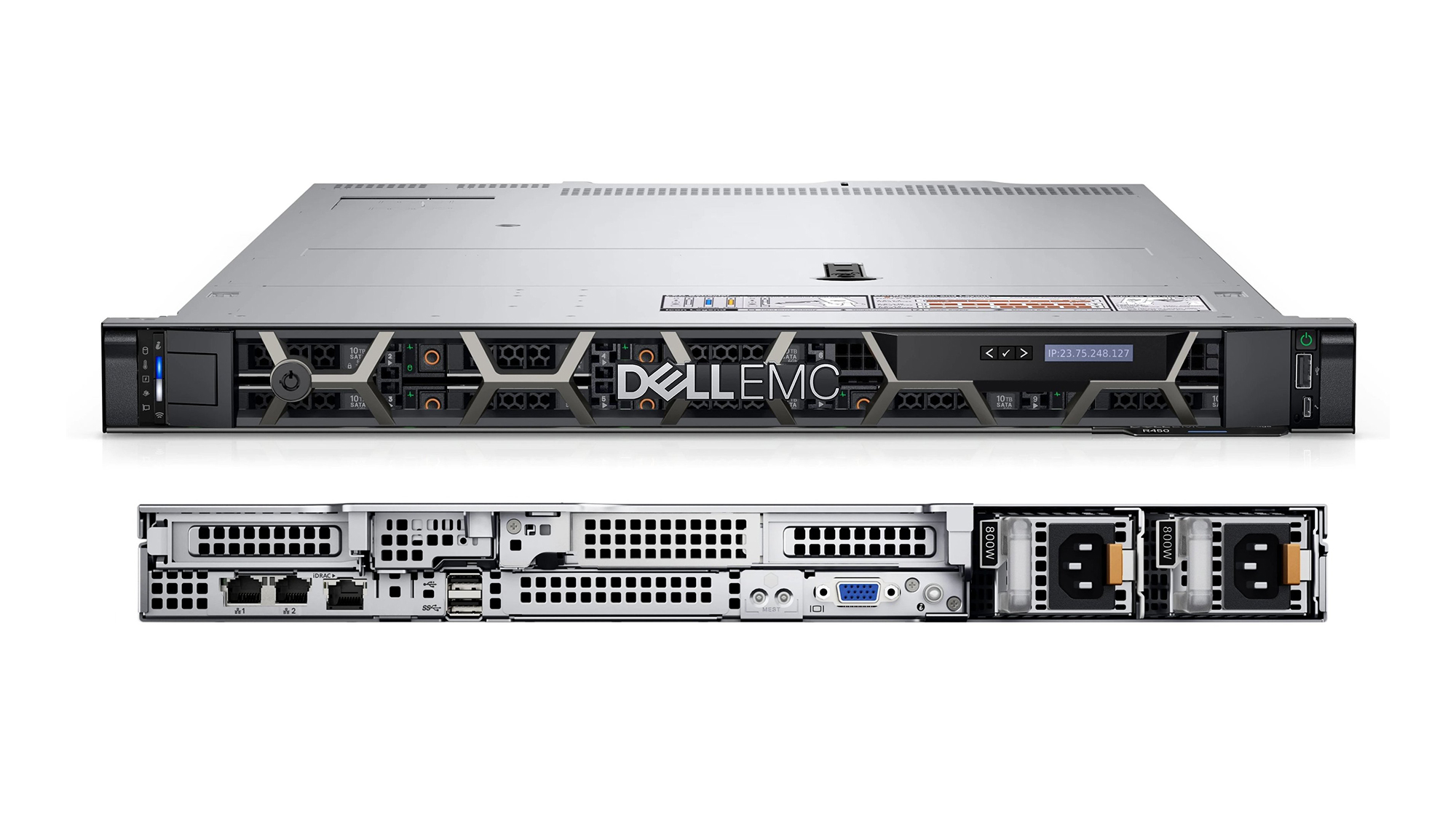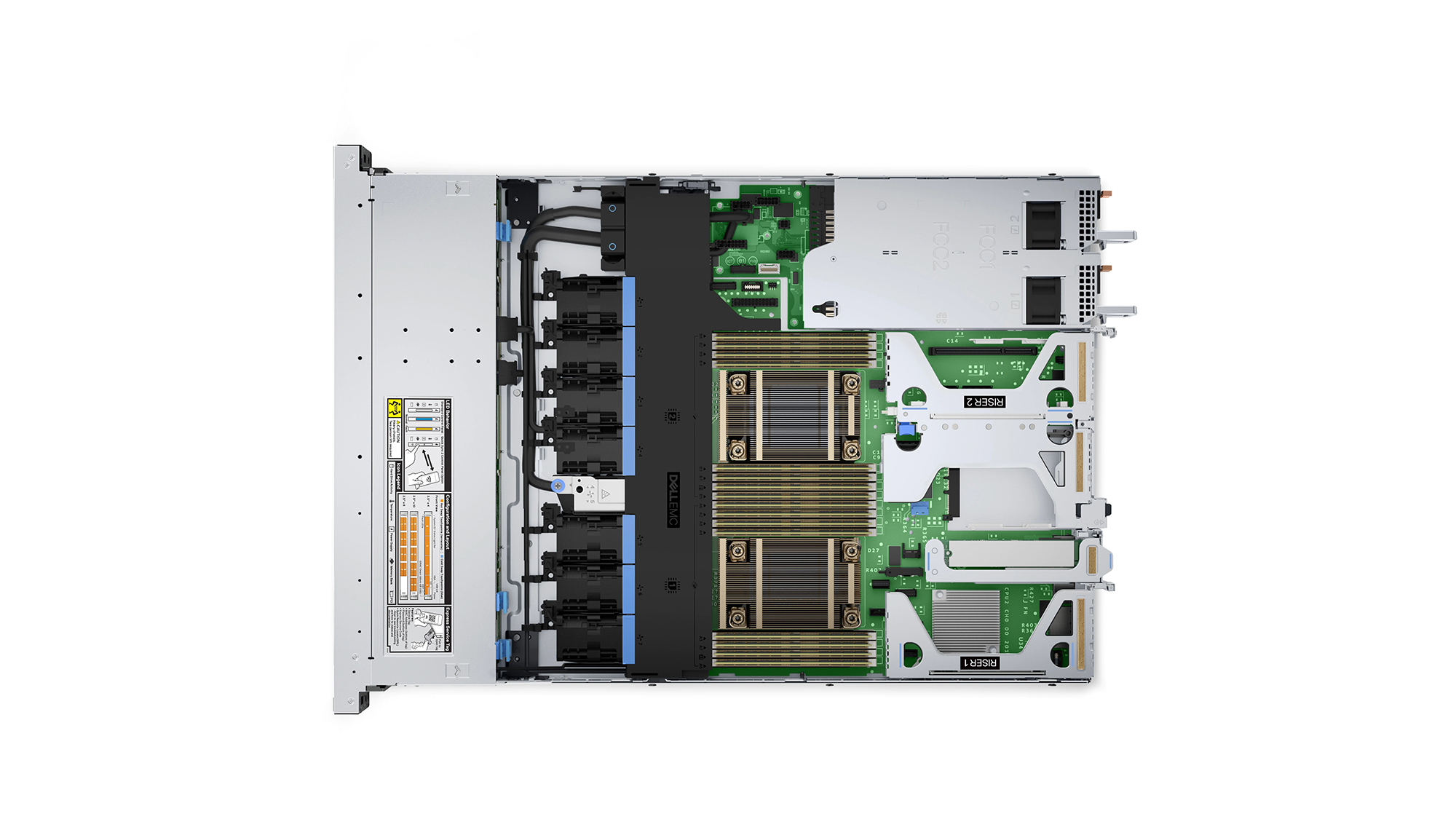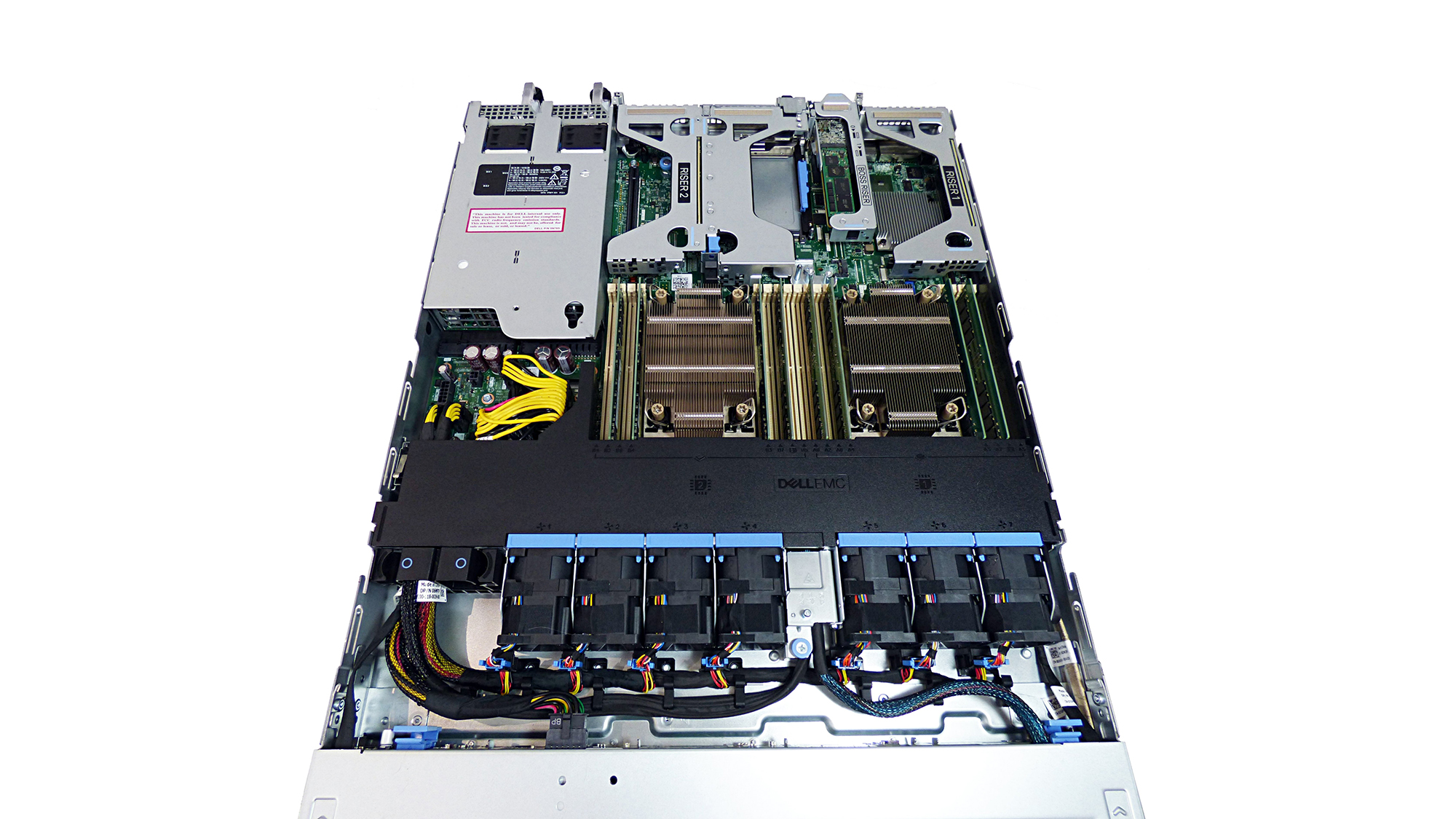Dell EMC PowerEdge R450 review: Rack-dense server power for SMBs
A versatile all-round rack workhorse with plenty of hardware choices at a good price


-
+
Good value
-
+
Gold and Silver Xeon Scalable CPUs
-
+
Decent storage potential
-
+
Top-notch management tools including CloudIQ

Businesses looking for an affordable rack server that can handle a wide range of general-purpose workloads will find the PowerEdge R450 could be just the ticket. Stepping up to the entry-point of Dell EMC’s dual-socket rack server family, the R450 targets SMB applications such as small IT infrastructure duties along with modest virtualisation services.
It packs a fine hardware package into its 1U height with plenty of processing power on tap thanks to a choice of seven Xeon Scalable Gen 3 CPUs. Our review system was furnished with a meaty pair of 24-core 2.1GHz Gold 5318Y modules – the highest the R450 can handle – but you can save a pile and opt for a more modest 8-core 2.8GHz Silver 4309Y.
Memory doesn’t see any real limits either, and the R450 can handle up to 1TB. Our system came tooled up for some memory-intensive action; the price includes a healthy 128GB of DDR4 memory spread across eight 16GB DIMMs.
Dell EMC PowerEdge R450 review: Storage options
The R450 is available with four hot-swap LFF drive bays or, in our case, eight SFF bays. The motherboard does have a basic embedded PERC S150 SATA controller for software-managed RAID arrays, but this is largely redundant as the R450 is offered with a choice of Dell EMC’s PERC hardware RAID cards which also bring SAS support into the equation.
Our server sports a PERC H745 Front SAS card which slots smartly into a dedicated bay right above the drive carriers, plugs directly into the backplane and is linked to the motherboard with a single cable. It supports all the usual RAID array suspects, including 5 and 6, plus it comes with a cache-protecting battery backup unit (BBU).

A good choice of SATA and SAS HDDs and SSDs are offered for the R450 but NVMe SSDs are off the menu. If you want these in 1U of rack space, you’ll need to consider moving up to the cost-optimised PowerEdge R650xs.
Dell’s BOSS (boot optimised storage solution) card does away with the need to put the OS on a hard disk but the R450 supports the older S1 version which doesn’t have the removable M.2 SSD carriers found in the later S2 model. The R450 has enough room between its two expansion card risers for a dedicated PCI-E slot where the BOSS-S1 card nestles, and we’ve priced the system up to include a pair of mirrored 480GB SSDs.
Sign up today and you will receive a free copy of our Future Focus 2025 report - the leading guidance on AI, cybersecurity and other IT challenges as per 700+ senior executives
Dell EMC PowerEdge R450 review: Remote management
The R450 is blessed with Dell EMC’s iDRAC9 controller which sets the standard for remote management. Its smart web console presents a wealth of information on system and component status, power usage and cooling efficiency, along with a full hardware inventory plus direct access to BIOS and storage configurations.
Costing only £115, the Quick Sync 2 module is a must-have feature for support staff that want walk-up diagnostics on their mobile device. Using the OpenManage Mobile (OMM) iOS app on an iPad, we connected to it over Bluetooth by scanning the QR code on the server’s pull-out system tag.
From our iPad, we could view all server information, alerts and the health status of hardware components. Other useful tools include facilities to directly access the iDRAC9 web console and use its built-in VNC server to remotely control the server’s operating system.

We run the OpenManage Enterprise (OME) software in the lab as a Hyper-V VM and after it discovered the server’s iDRAC9, we could manage and monitor it, control power and run remote control sessions. With an OME Enterprise Advanced license added to our iDRAC9, we could use the Power Manager plug-in to view graphs of server power consumption and thermals going back up to a year.
As long as the server has a valid support contract, you can integrate it with the free CloudIQ cloud hosted service, which provides server telemetry and predictive analytics. Installing the CloudIQ plug-in allows OME to operate as a collector where it sends its logs every 15 minutes. This means CloudIQ can provide a proactive health score, hardware inventory and 24-hour performance graphs of CPU and memory utilisation, power consumption and temperatures.
Dell EMC PowerEdge R450 review: Internal design
Cracking the lid reveals a well-designed interior that afforded us easy access to all key components. The two Gold CPUs are topped off with chunky passive heatsinks and flanked by a total of 16 DIMM slots supporting up to 64GB RDIMM modules - although these bad boys will set you back over £1,600 apiece.
At the rear are two risers, each offering a PCI-E Gen 4 expansion slot for a low-profile, half-length adapter card. There’s room for further network expansion as sitting underneath the risers is an OCP 3 mezzanine edge slot. with Dell EMC offering a choice of multi-port Gigabit, 10GbE and 25GbE cards from Intel, Broadcom and Marvell.
The R450 supports dual PSUs and our system included two 800W Platinum models running in fault tolerant mode. Also available are high-power 1,100W PSUs, while systems with a single CPU can get away with cheaper 600W models.

Cooling is handled by a bank of seven standard cold-swap, dual rotor fans arranged behind the drive backplane and although they do a good job, we recommend ensuring there is unobstructed air flow around the server. We found the Gold 5318Y CPUs get quite hot during operation, with the iDRAC9 temperature monitor showing them running at 80℃ in idle.
Dell EMC PowerEdge R450 review: Verdict
The R450 is a good choice for SMBs and larger businesses that want a rack-dense solution for running a wide range of general-purpose applications - although if you choose the core-dense Gold CPUs, be mindful of cooling requirements. That aside, this 1U rack server offers a good specification for the price, and if remote server management is a high priority, then you’ve come to the right place.
Dell EMC PowerEdge R450 specifications (as reviewed)
| Chassis | 1U rack |
| CPU | 2 x 24-core 2.1GHz Intel Xeon Scalable Gold 5318Y |
| Memory | 128GB 3,200MHz ECC DDR4 (max 1TB) |
| Storage bays | 8 x hot-swap SAS/SATA SFF (max 8) |
| RAID | Dell PERC H745 front SAS with 4GB cache and BBU |
| Storage included | 2 x 900GB SAS SFF HDDs |
| Other Storage | Dell BOSS-S1 with 2 x 480GB M.2 SATA SSDs |
| Network | 2 x Gigabit LOM |
| Expansion | 2 x PCI-E 4, 1 x OCP 3 edge slot |
| Power | 2 x 800W Platinum hot-plug PSUs |
| Other | LCD bezel, Quick Sync 2 module |
| Management | Dell iDRAC9 Datacenter with OME Advanced |
| Warranty | 3Yr Standard On-Site NBD |
Dave is an IT consultant and freelance journalist specialising in hands-on reviews of computer networking products covering all market sectors from small businesses to enterprises. Founder of Binary Testing Ltd – the UK’s premier independent network testing laboratory - Dave has over 45 years of experience in the IT industry.
Dave has produced many thousands of in-depth business networking product reviews from his lab which have been reproduced globally. Writing for ITPro and its sister title, PC Pro, he covers all areas of business IT infrastructure, including servers, storage, network security, data protection, cloud, infrastructure and services.
-
 Gender diversity improvements could be the key to tackling the UK's AI skills shortage
Gender diversity improvements could be the key to tackling the UK's AI skills shortageNews Encouraging more women to pursue tech careers could plug huge gaps in the AI workforce
By Ross Kelly Published
-
 Researchers claim Salt Typhoon masterminds learned their trade at Cisco Network Academy
Researchers claim Salt Typhoon masterminds learned their trade at Cisco Network AcademyNews The Salt Typhoon hacker group has targeted telecoms operators and US National Guard networks in recent years
By Emma Woollacott Published
-
 HPE says unified channel strategy won't force Juniper partners to generalize
HPE says unified channel strategy won't force Juniper partners to generalizeNews Does the company embrace specialists or want a full portfolio push? The answer, it seems, is both
By Jane McCallion Published
